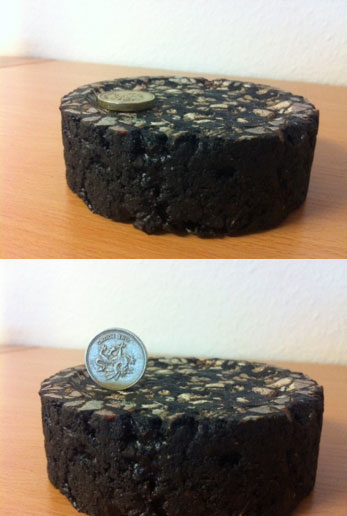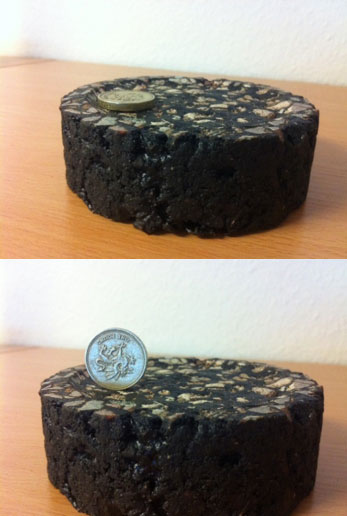Silent Asphalt
A rule to go by is that the bigger the stone size in the asphalt, the better are the wear properties, but then the noise from transporting vehicles will also be higher. The high quality that Tösseryoliten™ possesses makes it possible to lay down asphalt with a smaller stone size than what is standard but without shortening the life expectancy of the asphalt. The result will be that the sound emission of the traffic is significantly lower than usual.
The company has been working with operators on the Swedish market and developed a technology that, with its high-quality aggregate, Rhyolite 0-8 mm, in combination with a special bitumen, Nynas Endura F1, creates asphalt that can be laid in thin layer with high strength, low noise level and low emissions of PM10 dust.
To the right you can see pictures of pucks of asphalt after five years of traffic on freeways.
Here are some facts
Prall value obtained from a method for hot mix asphalt measuring abrasion resistance, SS- EN 12697-16. Requirements from the Swedish road authorities are that prall value may not exceed 25 after five years of traffic on freeways and 28 for municipal streets.
In December 2012 we ordered the NCC's operations at a laboratory at Tagene in Gothenburg, a measurement of the prall value for an asphalt mixture with Rhyolite 0-8 mm, Endura F1, rubber, cement and fibers. Prall value was 8.
A test was done afterwards with Rhyolite 0-8 mm and Endura F1.
Prall value became 12.
On the initiative of Åke Sandin, from the Traffic office in Gothenburg, was a control measurement with Rhyolite 8-11 mm, Tagene mm, Tagene 4-8 0-2 mm and Endura F1 done.
Prall value became 7.
At a laying of 25 mm asphalt in November 2013 was a mixture of Rhyolite 4-8 mm, Tagene 0-2 mm and Endura F1 tested.
Prall value was 14.
To find out out different bitumen affects the wear, NYPOL 73 was used combined with Tösseryolit™ 0-8 mm at testing in 2015.
Prall value was 19.

